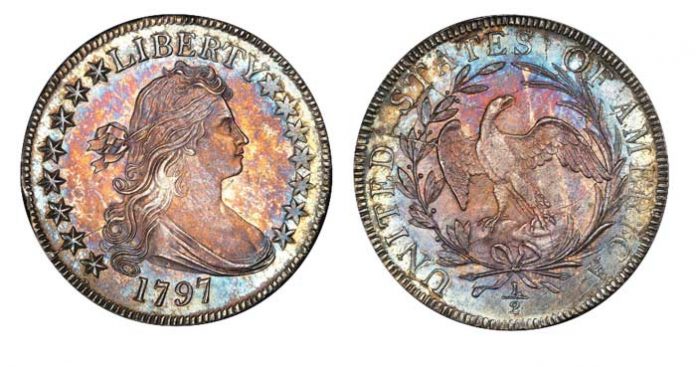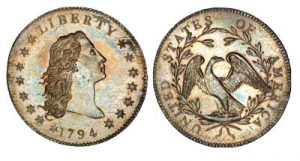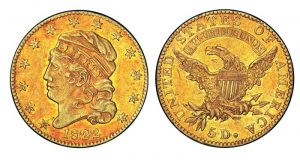
Rare coins and valuable coins of the highest artistic value have grown in demand vver the past several years. Some collectors are acquiring items with solid historical interest as well as true worth.
These coins are not being bought as an investment because no one knows what the future holds. In all fairness to the buyers, however, most persons wish to at least break even when their collections reach the auction block.
The acquisition of such coins may also fall under the heading of owning a trophy. It is human nature for both rich and poor to want something that no one else has. The Show and Tell part of a coin club meeting has always been a strong part of the numismatic world. Bragging rights in collector circles are an integral part of the hobby and will continue as long as there are collectors.
A coin can be of extreme rarity but attract little interest. On the other hand, those coins with historical associations, especially with well-known political leaders, tend to score well in auctions and private sales by dealers.
Coins of the United States
For coins of the United States, the emphasis has been on the early coins of the late 18th century and the earlier part of the 19th century. We see coins from this era as those from a struggling new nation wishing its coins to be accepted by the powers in Europe. Many of America’s earliest coins did find their way to Europe, and over the past few decades have been repatriated by astute collectors and dealers.

The first United States silver dollar is perhaps an ideal case in point. Fewer than 2,000 pieces were struck in October 1794, and examples of this coin, even in well-worn condition, bring very strong prices. However, the coin sold by Stack’s Bowers in January 2013 was head and shoulders above the others. Graded Specimen 66, it brought the amazing sum of about $10 million after very spirited bidding by would-be owners.
Three additional matters made this coin even more desirable. It had originally been a part of the incomparable collection formed by Virgil Brand, but has the added luster of carrying one of the special plugs of silver used to bring the weight of the coin into the proper narrow range permitted by law.
The third reason for this coin being important was that it was struck on an illegal standard. Before silver coinage had begun in 1794, the smelter and refiner, Albion Cox, had persuaded Mint Director David Rittenhouse that America’s silver coins would turn black in daily use if the legal fineness,0.8924+, was used. He suggested 0.900, and this was carried out until late October 1795 when a new director ordered that the law be obeyed to the letter.
1797 Half Dollar
A second example is a 1797 half dollar, graded MS–66, and sold by Stack’s Bowers in March 2021 as once part of the exquisite Pogue collection. It brought$1.68 million, again after strong bidding from interested collectors. This coin also came several years earlier from the Virgil Brand collection, a distinct plus in its favor.
The 1797 half dollar had two special points going for it. Only a few thousand pieces were struck in that far-off year. It was also the final year for George Washington’s presidency, a fact well known then and now.
This 1797 half dollar has even more going for it than just a small mintage. The year 1797 was a very hard time for the Mint and its employees. Due to the scandal over the illegal standard, the amount of silver brought in for recoining into American coins fell drastically in 1796 and was even worse in 1797. Mint Director Elias Boudinot was faced with the unpleasant task of laying off key members of the Mint staff, including those with special skills.
To get around this difficult problem, Boudinot ordered the coinage of half dimes, dimes, quarter dollars, and half dollars in small amounts. The demand from depositors was for silver dollars, but it takes as long to make a dime as it does a dollar, thus stretching out the bullion on hand and keeping the workers busy.
Half Dollar Special Feature
The half dollars of 1796 and 1797 have another special feature. This is the fraction “1/2” at the lower edge of the reverse, signifying a half dollar. Dollars and half dollars were edge-lettered, the value thus appearing on the edge, but this was the first time that the denomination was on one of the faces of the coin. The next appearance, for either silver or gold, was on the quarter dollars struck in 1804 and later. Values for gold coins did not appear until 1807.
1822 Half Eagle

The last coin to be examined is the 1822 half eagle or $5 gold piece. It was sold by Stack’s Bowers in March 2021 for $8.4 million, a stunning price for an American gold coin.
This coin was struck at a time when gold coins of the United States no longer circulated in the marketplace. The monetary system of the country, as established in 1792, was bimetallic, meaning that gold and silver were of equal importance. The ratio between the two metals was set at 15 to 1, indicating that 15 ounces of silver were equal to one ounce of gold.
By about 1800, however, the international ratio had changed and was now closer to 15.5 to one. This undervalued our gold, resulting in silver being used to buy the gold coins and ship them to Europe. This process accelerated after 1810, and by 1820 very little gold was to be found in the banks. A fair amount of gold was hoarded by individuals, however, providing many of the coins from this period available to collectors today.
Gold Coins of the 1820s
American gold coins of the 1820s are very rare today because most of them were exported not long after being struck. The 1822 half eagle is a special case even among these many rare dates from the 1820s and early 1830s. About 18,000 half eagles were struck in 1822 but mint records never show how many were struck with a given date. It’s possible the true mintage of half eagles carrying the 1822 date is under 1,000 pieces.
Only three 1822 half eagles are in existence, two of them being in the national collection at the Smithsonian. The coin illustrated here is the only known such coin in private hands; it was once part of the legendary Eliasberg collection, which had a specimen of every single United States coin issued for circulation.
The coins examined here are part of a larger picture where outstanding coins are given special attention by those with the inclination and means to acquire the best. This trend assures future collectors that such outstanding coins will always be a desirable aim for a collection.
This article about rare coins previously appeared in COINage magazine. Click here to subscribe! Story by R.W. Julian.















